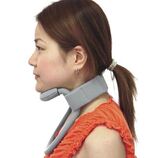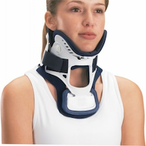|
If you find that your neck muscles are getting weaker and it is more challenging to hold your head up, a neck brace, often called a cervical brace or collar, can support the weight of your head and take the strain off your neck muscles.
A cervical collar can help you look straight ahead and engage more easily in daily activities like socializing, using the computer, and watching TV. It can also reduce your neck and shoulder pain, save you energy, improve your posture, and help with balance. |
|
There are many different types of neck braces. Your physical therapist or orthotist can assess your individual needs and recommend the best one for you. These premade neck braces come in different sizes and can be adjusted. The two most common styles for people living with ALS are:
When should I wear my neck brace?
You will want to wear your neck brace when you feel you most need it, such as when you are riding in a vehicle, transferring, or standing or sitting upright for long periods of time. There will be other times, such as bathing or using the toilet, when you might also find it helpful.
You do not have to wear your neck brace every moment you are awake. When you are relaxing at home, think about positioning yourself so you can offload your neck muscles. You can tilt back in a lift chair recliner, for example, and use a U-shaped travel pillow to support your head.
If you are in a custom power wheelchair, you may find that tilting and reclining your chair will provide enough head and neck support that you do not need your brace while in that position. However, if you are driving your chair or riding in a van while in your chair, your neck brace will help prevent your head from moving around.
If you have a neck brace and want to drive, talk with your occupational therapist first. Driving could be dangerous if you are unable to easily turn your head from side to side. If you have aids like a backup camera and blind-spot detectors, you may be able to drive safely once you’ve talked with your occupational therapist about strategies and modifications. If you have weak neck muscles but don’t wear a brace while driving, you could run the risk of injury in the event of a crash or sudden stop.
You may or may not want to wear your neck collar while eating. If you tend to tuck your chin to help you swallow, for example, you may find that you need to loosen your collar or take it off. Your speech language pathologist can work with you on eating and swallowing strategies.
You do not have to wear your neck brace every moment you are awake. When you are relaxing at home, think about positioning yourself so you can offload your neck muscles. You can tilt back in a lift chair recliner, for example, and use a U-shaped travel pillow to support your head.
If you are in a custom power wheelchair, you may find that tilting and reclining your chair will provide enough head and neck support that you do not need your brace while in that position. However, if you are driving your chair or riding in a van while in your chair, your neck brace will help prevent your head from moving around.
If you have a neck brace and want to drive, talk with your occupational therapist first. Driving could be dangerous if you are unable to easily turn your head from side to side. If you have aids like a backup camera and blind-spot detectors, you may be able to drive safely once you’ve talked with your occupational therapist about strategies and modifications. If you have weak neck muscles but don’t wear a brace while driving, you could run the risk of injury in the event of a crash or sudden stop.
You may or may not want to wear your neck collar while eating. If you tend to tuck your chin to help you swallow, for example, you may find that you need to loosen your collar or take it off. Your speech language pathologist can work with you on eating and swallowing strategies.
|
Sign up for our free newsletter to stay up-to-date on new content, equipment, ALS news, resources, and more.
|
What if I find my neck brace uncomfortable?
At first, your neck brace may feel confining or uncomfortable. It will likely take time to get used to it. Because ALS affects everyone differently, your brace may need some individual adjustments or modifications. If you notice red spots or skin irritation, or if you feel your neck brace is not giving you the support you need, contact your physical therapist or orthotist.
Some people living with ALS end up making small modifications to their neck braces, such as adding extra padding. Some prefer to use travel pillows at times even though they provide less support. You may find that alternating between a rigid brace and a softer option, according to the activity or time of day, works best for you.
Some people living with ALS end up making small modifications to their neck braces, such as adding extra padding. Some prefer to use travel pillows at times even though they provide less support. You may find that alternating between a rigid brace and a softer option, according to the activity or time of day, works best for you.
Can stretching help?
Stretching can help reduce neck pain and stiffness, which will give you greater range of motion when moving your head up and down and side to side. Your caregiver can support your head and help you perform gentle range of motion exercises to maintain your flexibility.
How much will I have to pay?
|
If you get a prescription from your doctor, Medicare should cover 80% of the cost of your neck brace. Medicaid, supplemental plans, and secondary private insurance should pay for the remaining 20%.
If you have Medicare but do not have Medicaid, a supplemental plan, or secondary private insurance, you will likely have to pay the remaining 20% out of your own pocket. |
|
Keep in mind that Medicare will only pay for one type of brace for the same body part once every five years, based on the logic that a brace should last you five years.
If you do not qualify for Medicare—but have Medicaid and/or private insurance—find out what your durable medical equipment (DME) benefits will cover. If you have a Medicare Advantage Plan, be sure to ask about your DME benefits.
If you are facing out-of-pocket expenses that you cannot afford, ask your local ALS organization if they can lend you a neck brace from their loan closet. If not, talk with your DME provider and/or local ALS organization about financial assistance options.
Military veterans: Your coverage for equipment, including braces, is different than what is listed here. Learn more.
If you do not qualify for Medicare—but have Medicaid and/or private insurance—find out what your durable medical equipment (DME) benefits will cover. If you have a Medicare Advantage Plan, be sure to ask about your DME benefits.
If you are facing out-of-pocket expenses that you cannot afford, ask your local ALS organization if they can lend you a neck brace from their loan closet. If not, talk with your DME provider and/or local ALS organization about financial assistance options.
Military veterans: Your coverage for equipment, including braces, is different than what is listed here. Learn more.





